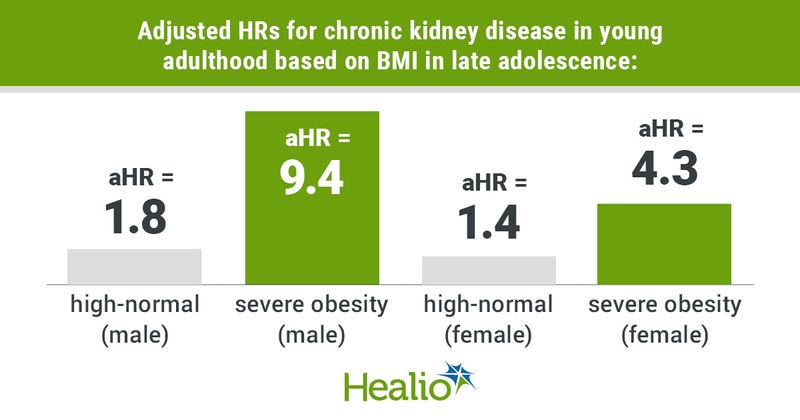High BMI in adolescence raises odds of chronic kidney disease in adulthood
Click Here to Manage Email Alerts
Key takeaways:
- Having a high BMI in late adolescence was associated with an increased risk for chronic kidney diseases in young adulthood.
- Even a high-normal BMI was associated with an increased risk.
A high BMI in late adolescence — even a high-normal BMI — was associated with increased odds of early chronic kidney disease in young adulthood, according to a study published in JAMA Pediatrics.
According to Avishai M. Tsur, MD, MHA, of Sheba Medical Center in Ramat Gan, Tel Aviv, Israel, and colleagues, adolescent obesity rates have been steadily increasing, with 1 in 5 adolescents in the United States having a BMI at or above the 95th percentile for age and sex on the CDC growth charts.

“Although the link between obesity and chronic kidney disease (CKD) in adults is well established, the evidence linking adolescent obesity and early CKD, particularly during young adulthood, is limited,” Tsur and colleagues wrote. “Moreover, it is unclear whether this association is independent of other obesity-related comorbidities, such as type 2 diabetes and hypertension.”
They retrospectively studied data on 593,660 Israeli adolescents (mean age at study entry, 17.2 years; 54.5% male) aged 16 to 20 years born after Jan. 1, 1975, who had medical assessments for mandatory military service. They excluded patients with kidney pathology, albuminuria, hypertension, dysglycemia, or missing blood pressure or BMI data. In a mean follow-up of 13.4 years, 0.3% of adolescents developed early CKD.
For males, the risk for developing CKD increased the most among those with severe obesity (adjusted HR = 9.4; 95% CI, 6.6-13.5) during adolescence, followed by mild obesity (aHR = 6.7; 95% CI, 5.4-8.4), overweight (aHR = 4; 95% CI, 3.3-5) and high-normal BMI (aHR = 1.8; 95% CI, 1.5-2.2).
Findings were similar among females, with the most increased risk for developing CKD in those with severe obesity (aHR = 4.3; 95% CI, 2.8-6.5) during adolescence, followed by mild obesity (aHR = 2.7; 95% CI, 2.1-3.6), overweight (aHR = 2.3; 1.9-2.8) and high-normal BMI (aHR = 1.4; 95% CI, 1.2-1.6).
The risk for developing CKD in young adulthood was also found to be increased by 1.5- to 2.7-fold for persons with overweight and obesity in adolescence even without incident diabetes or hypertension.
“In this cohort study, high BMI in late adolescence was associated with early CKD in young adulthood, which can occur even in seemingly healthy individuals with high-normal BMI and before the age of 30 years,” the researchers wrote. “Given the increasing obesity rates among adolescents, our findings are a harbinger of the potentially preventable increasing burden of CKD and subsequent cardiovascular disease.”
Reference:
High adolescent BMI increases risk of early chronic kidney disease, according to JAMA study by Hebrew University researchers. https://www.eurekalert.org/news-releases/1030070. Published Jan. 2, 2024. Accessed Jan. 3, 2024.
Tsur AM, et al. JAMA Pediatr. 2023;doi:10.1001/jamapediatrics.2023.5420.
